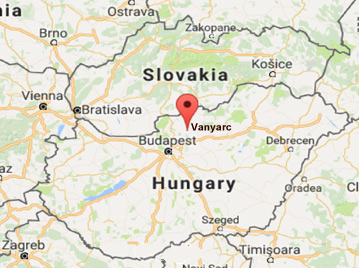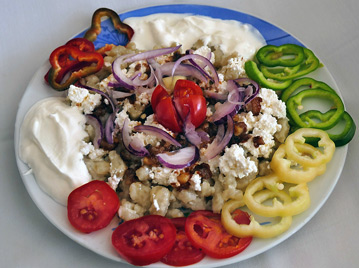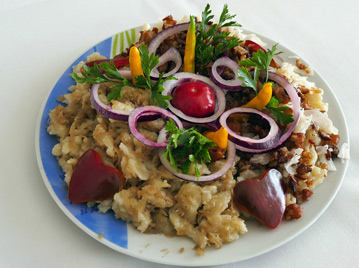
This characteristic soft egg noodle with finely grated potatoes in the dough is poached in a creamy sheep cheese sauce and has crispy lardons scattered on top. Widely known to originate from the Slovakian region, with Hungary as a firm fan. Hungarians mostly refer to this dish as “sztrapacska” these days, which is slightly incorrect but nobody seems to mind as long as they can get their fork into one. As an interesting side note “sztrapacska” is the name for the version with cabbage and meat (kapustové strapačky in Slovak) and the sheep cheese version is the “haluska” (bryndzové halušky).
Ingredients – makes 2 large portions, feeds 3 fine, 4 skinny people would be stuffed
- 400g (0.9 lb) peeled potatoes
- 200g (1.6 cup) plain flour
- 1 egg
- 120 ml ( 0.5 cup) water
- 100 g diced bacon lardons
- 1 medium onion, chopped
- 250 ml (1 cup) sour cream
- 150-200g crumbly Bryndza sheep milk cheese or Feta cheese
- salt / black pepper to taste
- fresh dill or parsley to serve (optional)
Method
- Slowly melt and fry the lardons in a larger frying pan, when crispy take the bacon bits out of the fat and set aside. Keep the fat in the pan we will use this for the sauce.
- Put a large pan of lightly salted water, just like for pasta, on the heat to slowly bring to the boil while we prepare the dough for the dumplings.
- Peel and great the potatoes on a fine grater then squeeze out the resulting liquid by hand. Transfer the squeezed grated potatoes to a new bowl if you need to.
- First add to the grated potatoes roughly the half of prescribed 1.6 cups of flour first, with a whole egg, half a cup of water and a large pinch of salt to the grated potatoes
- Combine thoroughly, then add enough from the rest of the flour to make the thick batter consistency, you may need less, you may need more.
- Now the water hopefully boiling, use a spratzel maker to create the small dumplings, alternatively you can make these without a special tool – use a knife to scrape small pieces of the dough from a tilted chopping board into the boiling water.
- Cook the little pasta droplets in gently boiling water until done – usually 5-7 minutes untill the potato in them cooks well – then lift out with a slotted spoon or strain and set aside for couple of minutes until we prepare the sauce.
- Finely chop a medium onion and warm up the bacon fat on the heat again. Gently fry the onion in the fat, add ⅔ of the sour cream and ⅔ of the sheap cheese, cook briefly until all hot
- Taste and add more seasoning if need to, bear in mind the fried bacon bits you add at the end can be quite salty.
- Time to combine the sauce and the cooked pasta, mix thoroughly, heat through until starts to bubble, then take off the heat.
- Serve with a bit more sour cream and cheese crumbled on top, scatter the cripsy bacon pieces all over and hint with the optional finely copped dill or parsly.
Tip: Don’t leave the grated potatoes or the dough made with them sit for too long, they can take on a grey colour.

Haluska festival and Sztrapacska cooking contest, Vanyarc, Hungary

The Haluska Festival and Sztrapacska Cooking Contest is held in the little known picturesc little village of Vanyarc in Hungary every year.
Teams made up by local folks busily prepare their best recipes to the delight of the sampling visitors. The event hosts other colourful programs, music and dance and local craft fair, must be a great day out!










Eva, I am back at work and my work computer will recieve your site. What is the correct spelling for the Hungarian T.V. Show; cooking and travelogue. “Itzarok”?
Hello Ronald, Good to hear you’re now back to the grind! Is it the program called “Ízőrzők” by any chance? There are epsidoes on Youtube, lots of great traditional cooking by different regions of Hungary.
I Teach in the Veteran’s Hospital where I also see amputees, and Orthotic patients. A new Resident from No. Western Univ. is 3/4 Hungarian, and remembers grandma making stuff! So I will get her to watch this show Izorzok. It has nice cuts of scenery mixed in. My Bride, Nancy , loves travel. I am not so sure about my wanderings. She wants to take kids to Tiszalok, and thereabouts, to see where Mom (Juliska) Erdely lived. Funny deal: Grandma Erdely’s maiden name was Balogh also. Same temperament as my dads people. That Grandpa was from Komoro, N.E. off the Tisza river. Coleman left in 1904 at 17. Was a horseman. U.S. Army tried to conscript him to chase the great Mexican Bandit, Poncho Villa! By then he was married and had 2 kids, and not a citizen yet. WAHLAH! Off the hook!
Hello–I know this post is old but I just had to comment. There are two KOMORO in Hungary and also in same county–Szatmár (now Szabolcs-Szatmár-Bereg) — one is Komoró, the other is Kömörö. Komoró is more North of the other and closer to river Tiszá, the other Kömörö is near Mánd and Nemesborzova–all settlements my grandmother, great-grandparents come from. Before WWI it was more in the middle of Hungary but after, the borders changed and became 30 min from Romanian and Ukrainian borders. My great-grandfather, came to USA 1918 first, it took 10 years to be able to bring the rest of his family in 1928. In 1940 , he returned to Nemesborzova, Hungary alone to care for his elderly father, my great-grand mother refused to return. Between conditions in Hungary/Europe at the time and contracting tuberculosis–he died there in 1942, shortly after his father.–Anyway, I hope your family got to travel to Hungary, it’s so important that each generation know where they come from, what their ancestors had to do to survive—-helps them to appreciate what they are able to have now, where ever they live now.
I Teach in the Veteran’s Hospital where I also see amputees, and Orthotic patients. A new Resident from No. Western Univ. is 3/4 Hungarian, and remembers grandma making stuff! So I will get her to watch this show Izorzok. It has nice cuts of scenery mixed in. My Bride, Nancy , loves travel. I am not so sure about my wanderings. She wants to take kids to Tiszalok, and thereabouts, to see where Mom (Juliska) Erdely lived. Funny deal: Grandma Erdely’s maiden name was Balogh also. Same temperament as my dads people. That Grandpa was from Komoro, N.E. off the Tisza river. Coleman left in 1904 at 17. Was a horseman. U.S. Army tried to conscript him to chase the great Mexican Bandit, Poncho Villa! By then he was married and had 2 kids, and not a citizen yet. WAHLAH! Off the hook! This is the first personal citation. Your system said I already posted it before. I don’t think so.
My Hungarian grandma made something like this, but I don’t remember it having potatoes in it? I believe she just used flour, egg & water…..used the scraping method, then when cooked she added sour cream & bacon. Does this sound familiar? I’m trying to figure out what part of Hungary she was from – she’s quite a mystery!!!!
Hi Teresa, oh yes that must have been the very popular nokedli! It is eaten everywhere in Hungary, often served plain as a side to meat dishes, stews. The version with sour cream and bacon must be a delicious meal on its own! Here is a version with just eggs. https://www.hungariantidbits.com/hungarian-egg-dumplings-tojasos-nokedli/
MY GRANDMOTHER USED TO MAKE ” HALUSHKA ” FOR ME WHEN I WAS A LITTLE BOY. IT WAS REALLY GOOD AND A REAL TREAT ! SHE WAS FROM THE NORTHERN REGION OF HUNGARY. THE VERSION SHE MADE WAS SIMPLER. ALL IT WAS WAS NOODLES, COTTAGE CHEESE AND BUTTER. I REMEMBER HER MAKING IT FOR ME. I LOOKED FORWARD TO IT.
♥ Lovely memories Bill, your grandmother’s version must have been very tasty, a recipe perfected through generations!
In my family, we know “haluska” (galuska?) as fried cabbage and noodles. Sometimes with some variations: maybe some bacon, sour cream, onion fried with the cabbage. I guess we mostly just fried cabbage (in lard or whatever available) and noodles since very poor after arriving in USA 1928 AND then the Great Depression hit. It is our comfort food —other people may have macaroni and cheese, or macaroni and tomato sauce—we always had haluska. Yum—-simple and tasty, filling, and cheap—–I still make at least every other week. When I eat it, it is like a hug from my Hungarian grandmother, aunts, mother who are all gone now. Always had dumplings filled with plum lekvar (sometimes small halved plums), boiled then pan sauteed with buttered, toasted breadcrumbs. We just called them plum dumplings–but I think called gombocsilvas (sp?)–ahhhh, yeah…need to make some now….. 🙂
Great comments